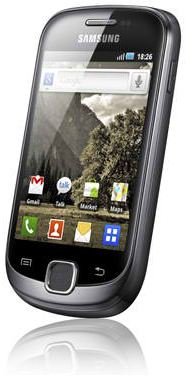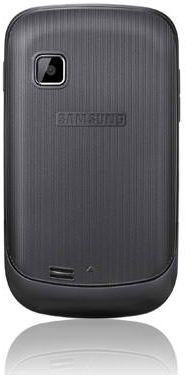Samsung Galaxy Fit Review - The Entry Level Galaxy Smartphone for 2011
The Samsung Galaxy S 2 was the major flagship sequel to the original Galaxy S. However, Samsung hasn’t forgotten about the low to mid tier markets with their new found presence in the smartphone market. At the 2011 Mobile World Congress, the Samsung Galaxy Fit was shown, along with the Galaxy Ace, Gio and Mini. It will be interesting to see how well Samsung markets each one to ensure that sales do not cannabilize.
The Samsung Galaxy Fit looks to be a competitor to the HTC Wildfire, the LG Optimus T (M, S, V, U, Vortex family) or even the Motorola Cliq 2. The Samsung Galaxy Fit follows in the footsteps of the Samsung Galaxy 3 and 5, which were the original Galaxy series of smartphones to aim at a lower end market than the Galaxy S.
Samsung Galaxy Fit Specifications:
- Dimensions: 0.34 x 2.41 x 0.50 inches (110.2 x 61.2 x 12.6 mm)
- Weight: 3.82 oz (108 g)
- Display: 3.3 inch LCD capacitive touchscreen display, 240 x 320 pixels
- Memory: 160 MB + 32 GB MicroSD
- OS: Android OS 2.2
- Processor: 600 MHz
- Camera: 5 megapixel
- Connectivity: GSM 850, 900, 1800, 1900 / UMTS 900, 2100
- Data: EDGE
- GPS: GPS with A-GPS
- Battery: Li-Ion 1350 mAh
Design and Display (3 out of 5)

The Samsung Galaxy Fit looks like a run of the mill Android powered handset. It has the now familiar candy bar design with a 3.3 inch capacitive touchscreen dominating the front of the smartphone. At the bottom are three buttons for menu, home, and back. The home button is a black pad, very much similar to its older brother the Samsung Galaxy S. A chrome like bezel surrounds the front of the phone, giving it an elegant look.
On the left edge resides the volume rocker and microSD slot. Opposite, on the right, resides the power button. Up top is the 3.5 mm headphone jack and microUSB used for charging. Rounding out the back is a nice plastic that is fingerprint resistant, with a 5 megapixel camera on the top left corner. Overall, the Samsung Galaxy Fit feels like a smaller, slightly fatter Samsung Galaxy S.
Hardware and Software (2 out of 5)
The Samsung Galaxy Fit falls a little below when it comes to the hardware arena, even for an entry level smartphone. The original Motorola CLIQ and the Galaxy Fit can be compared, which is not a good thing. However, at the 2011 Mobile World Congress, the Fit was able to run the preloaded Android 2.2 operating system with no noticeable lag.
Like its other brethren, the Samsung Galaxy Fit is preloaded with Android 2.2 and TouchWiz 3, Samsung’s proprietary overlay to enhance users’ experiences. Sadly, the Galaxy Fit only comes with 160 MB of internal storage so an external microSD card is a must. Overall, while it does look to be smooth and powerful, the internal hardware is a bit lacking and, even for an entry level smartphone, this is a weak offering.
User Interface (3 out of 5)
The Samsung Galaxy Fit has your run of the mill, easily identifiable user interface that comes with Android powered smartphones. While TouchWiz UI does offer a slight enhancement of user experience, the Samsung Galaxy Fit feels no different from its other Samsung brethren that have Android. Like other Android powered handsets, the touchscreen interface makes the Galaxy Fit easy to pick up and use, even for beginners.
TouchWiz UI may turn some hardcore Android fans away from the Galaxy Fit, but it comes with buying a Samsung device that has Android. TouchWiz gives the Galaxy Fit a more iOS feel, like it does to the Samsung Fascinate or any other Galaxy S device. Unlike HTC’s line up which uses Sense UI to enhance the Android feel. Overall, the user interface is the average Android user interface, and the 600 MHz processor doesn’t cause any noticeable lag. It very much feels like a ‘mini’ Samsung Galaxy S, which is a good thing.
Features (3 out of 5)
The Samsung Galaxy Fit comes with a 5 megapixel camera without any kind of flash, just like its older,

more expensive brothers, the Samsung Captivate and Vibrant. The camera itself was decent and for an entry level smartphone, a 5 megapixel camera is quite an upgrade from the usual 2 to 3 megapixels. The camera also takes video, though it only shoots in 240 x 320 at 15 frames per second, which means the video recording capability is rather lacking when compared to its expensive brethren. Not exactly the most amazing video recording capabilities, but for an entry level smartphone, it is acceptable.
The camera feature may not easily replace an actual digital camera but its still a nice point and shoot camera to carry around when you don’t have a separate camera or if you leave yours at home. The other “feature” would be the ability to access the Android Market, due to the Galaxy Fit running Android 2.2. By having the ability to access the Android Market, the Samsung Galaxy Fit can gain access to over 100,000 applications.
The Final Verdict (3 out of 5)
Overall, the Samsung Galaxy Fit ranks in as a solid “Average” entry level smartphone. While the hardware specifications are a bit lacking and slightly disappointing, the rest of the feature set makes up for it. Samsung may have made a mistake announcing similar entry level smartphones at the same time as the Galaxy Fit. The Samsung Galaxy Fit also has quite a competitive line up to go against, such as the Motorola Cliq 2, the LG Optimus T (S,M,U,V, Vortex) family and the Motorola Charm. The Samsung Galaxy Fit could be the entry level smartphone to put Samsung even higher on the map or it could be just another smartphone lost in the crowd.
References
- Source: Author’s experience
- Image Credit: Androidos, https://androidos.in/wp-content/uploads/2011/01/Samsung-Galaxy-Fit1.jpg
- Image Credit: Androidos, https://androidos.in/wp-content/uploads/2011/01/Samsung-Galaxy-Fit_back.jpg